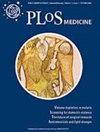预防、诊断和治疗产后出血的成本效益:经济评价的系统回顾
IF 9.9
1区 医学
Q1 MEDICINE, GENERAL & INTERNAL
引用次数: 0
摘要
背景产后出血(PPH)是一种产科急症。虽然在高资源环境中,与 PPH 相关的死亡相对较少,但在资源有限的环境中,PPH 仍是孕产妇死亡的主要原因。我们对产后预防、诊断或治疗 PPH 的干预措施进行了系统性回顾,以确定、评估和综合成本效益证据。方法和结果 本系统综述在 PROSPERO 上进行了前瞻性注册(CRD42023438424)。我们在 2023 年 6 月 22 日至 2024 年 7 月 11 日期间检索了 Medline、Embase、NHS 经济评估数据库 (NHS EED)、EconLit、CINAHL、Emcare、Web of Science 和 Global Index Medicus,没有日期或语言限制。对预防、检测或处理 PPH 的任何产后干预措施进行的全面经济评估均符合条件。研究筛选、数据提取和质量评估(使用 CHEC-E 工具)由至少两名审稿人独立完成。我们对每项干预措施的现有证据进行了叙述性综合。从 3,993 条引文中,我们纳入了 56 项研究:其中 33 项研究涉及预防干预,1 项研究评估了诊断方法,17 项研究涉及治疗干预,1 项研究比较了预防和治疗,4 项研究评估了护理捆绑。24 项研究在高收入国家进行,22 项在中上或中低收入国家进行,3 项在低收入国家进行,7 项研究涉及多种收入水平的国家。研究环境、方法和结果差异很大。研究结果最一致的干预措施是使用氨甲环酸治疗 PPH 和使用护理捆绑包。在这两种情况下,多项研究预测这些干预措施要么会带来更好的医疗效果并节约成本,要么会以可接受的成本带来更好的医疗效果。本综述的局限性包括:没有选择理想的环境,因此没有进行可移植性评估。此外,与其他不确定性来源相比,本综述对某些研究不确定性来源(如有效性参数)进行了更深入的研究。结论 在这项系统性综述中,我们提取、严格评估并总结了来自 56 项研究的成本效益证据,这些研究涉及 16 种不同的 PPH 预防、诊断和治疗干预措施。在 PPH 治疗中使用氨甲环酸,以及在预防、诊断和治疗过程中使用 PPH 综合捆绑疗法,在各种情况下都有支持性的成本效益证据。需要更多利用最佳实践原则进行的研究,才能对哪些干预措施具有最佳价值做出更有力的结论。世界卫生组织(WHO)推荐的几种高优先级干预措施,如使用额外的子宫收缩剂、非气动防震服或子宫球囊填塞术(UBT)来治疗 PPH,需要在高、中、低资源环境中进行强有力的经济评估。本文章由计算机程序翻译,如有差异,请以英文原文为准。
The cost-effectiveness of preventing, diagnosing, and treating postpartum haemorrhage: A systematic review of economic evaluations
Background Postpartum haemorrhage (PPH) is an obstetric emergency. While PPH-related deaths are relatively rare in high-resource settings, PPH continues to be the leading cause of maternal mortality in limited-resource settings. We undertook a systematic review to identify, assess, and synthesise cost-effectiveness evidence on postpartum interventions to prevent, diagnose, or treat PPH. Methods and findings This systematic review was prospectively registered on PROSPERO (CRD42023438424). We searched Medline, Embase, NHS Economic Evaluation Database (NHS EED), EconLit, CINAHL, Emcare, Web of Science, and Global Index Medicus between 22 June 2023 and 11 July 2024 with no date or language limitations. Full economic evaluations of any postpartum intervention for prevention, detection, or management of PPH were eligible. Study screening, data extraction, and quality assessments (using the CHEC-E tool) were undertaken independently by at least 2 reviewers. We developed narrative syntheses of available evidence for each intervention. From 3,993 citations, 56 studies were included: 33 studies of preventative interventions, 1 study assessed a diagnostic method, 17 studies of treatment interventions, 1 study comparing prevention and treatment, and 4 studies assessed care bundles. Twenty-four studies were conducted in high-income countries, 22 in upper or lower middle-income countries, 3 in low-income countries, and 7 studies involved countries of multiple income levels. Study settings, methods, and findings varied considerably. Interventions with the most consistent findings were the use of tranexamic acid for PPH treatment and using care bundles. In both cases, multiple studies predicted these interventions would either result in better health outcomes and cost savings, or better health outcomes at acceptable costs. Limitations for this review include that no ideal setting was chosen, and therefore, a transferability assessment was not undertaken. In addition, some sources of study uncertainty, such as effectiveness parameters, were interrogated to a greater degree than other sources of uncertainty. Conclusions In this systematic review, we extracted, critically appraised, and summarised the cost-effectiveness evidence from 56 studies across 16 different interventions for the prevention, diagnosis, and treatment of PPH. Both the use of tranexamic acid as part of PPH treatment, and the use of comprehensive PPH bundles for prevention, diagnosis, and treatment have supportive cost-effectiveness evidence across a range of settings. More studies utilizing best practice principles are required to make stronger conclusions on which interventions provide the best value. Several high-priority interventions recommended by World Health Organization (WHO) such as administering additional uterotonics, non-pneumatic anti-shock garment, or uterine balloon tamponade (UBT) for PPH management require robust economic evaluations across high-, middle-, and low-resource settings.
求助全文
通过发布文献求助,成功后即可免费获取论文全文。
去求助
来源期刊

PLoS Medicine
医学-医学:内科
CiteScore
21.60
自引率
0.60%
发文量
227
审稿时长
3 months
期刊介绍:
PLOS Medicine aims to be a leading platform for research and analysis on the global health challenges faced by humanity. The journal covers a wide range of topics, including biomedicine, the environment, society, and politics, that affect the well-being of individuals worldwide. It particularly highlights studies that contribute to clinical practice, health policy, or our understanding of disease mechanisms, with the ultimate goal of improving health outcomes in diverse settings.
Unwavering in its commitment to ethical standards, PLOS Medicine ensures integrity in medical publishing. This includes actively managing and transparently disclosing any conflicts of interest during the reporting, peer review, and publication processes. The journal promotes transparency by providing visibility into the review and publication procedures. It also encourages data sharing and the reuse of published work. Author rights are upheld, allowing them to retain copyright. Furthermore, PLOS Medicine strongly supports Open Access publishing, making research articles freely available to all without restrictions, facilitating widespread dissemination of knowledge. The journal does not endorse drug or medical device advertising and refrains from exclusive sales of reprints to avoid conflicts of interest.
 求助内容:
求助内容: 应助结果提醒方式:
应助结果提醒方式:


